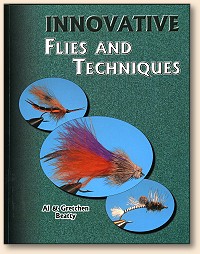After making the changes he asked Tom Piccolo to act as
his field tester because "pic" fished and guided the marshes
of south Louisiana almost daily. After four months of testing
the pattern on a daily basis they concluded it was one of the
best flies for redfish either had ever used. It is particularly
effective when retrieved using a very slow three-inch strip
followed by a pause. The strip-pause-strip retrieve allows
the fly to work its magic.
Materials List: The Mohawk or Pic's Special
Hook: Size 2/0 - 2, saltwater
Thread:- Red.
Tail: Olive Flashabou over olive marabou.
Tail flank: Two pheasant flank feathers.
Eyes: Yellow barbell.
Body: Wide Mylar tubing, olive Zonker strip.
Legs: Red rubber strips.
Coating: Clear nail polish with gold and green flecks.
Tying Method: The Mohawk or Pic's Special

1. Mount the hook in the vise and apply a thread
base that extends over the whole shank and into the
bend. Tie on a clump of olive marabou that is twice
as long as the hook. Select several strands of olive
or pearl Flashabou and tie them to the shank to accent
the tail. Leave the thread at the back of the hook.

2. Select two well-marked pheasant feathers and
strip the fuzzy material from the base of the stem.
Tie one on the off side of the hook parallel with
the tail. Repeat the process on the near side of
the hook to complete the tail flank.

3. Pick a section of olive Zonker strip and tie it
on the hook in the bend. It must be upside down and
the natural direction of the fur should be pointing
forward so the fur will sweep back when it is folded over
in a future step. Use an iron to flatten a section of
the gold mylar tubing. Slip it over the hook and anchor
it in the bend on top of the Zonker strip. Press the
tubing flat with the thumb and forefinger.

4. Anchor the barbell eyes in the bend of the hook with
several crisscross wraps, whip finish, and remove the
thread. Move forward to the front of the hook and tie
the thread back on while binding the tubing to the shank
just behind the eye. Trim off any waste tubing then wrap
a thread head covering the clipped ends.

5. Pull the Zonker strip over the body, anchor it behind the
hook eye, and trim the excess material. Tie on the red
rubber strips to form four legs. They should be long
enough to reach to the center of the tail flank feathers.

 6. Whip finish and remove the thread from the hook.
Turn it over in the vise or rotate the jaws like we did.
Apply a line of super glue to the Mylar tubing on either
side of the shank so it will soak through and anchor the
Zonker strip to the top of the body (which really is the
bottom of the fly because it travels through the water
hook-point up). Whe the super glue has dried, apply a
coat of clear fingernail polish to the bottom of the
Mylar (top f the fly) and accent it with sparkle flecks;
Tom likes gold and light green. ~ Gretchen and Al
6. Whip finish and remove the thread from the hook.
Turn it over in the vise or rotate the jaws like we did.
Apply a line of super glue to the Mylar tubing on either
side of the shank so it will soak through and anchor the
Zonker strip to the top of the body (which really is the
bottom of the fly because it travels through the water
hook-point up). Whe the super glue has dried, apply a
coat of clear fingernail polish to the bottom of the
Mylar (top f the fly) and accent it with sparkle flecks;
Tom likes gold and light green. ~ Gretchen and Al
Credits: This fly is just one of hundreds of terrific
step-by-step patterns in Innovative Flies and Techniques
by Al and Gretchen, published by Frank Amato Publications. There
is a review of the book
HERE.



